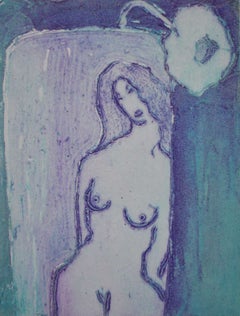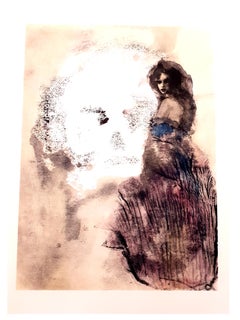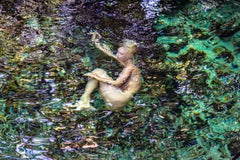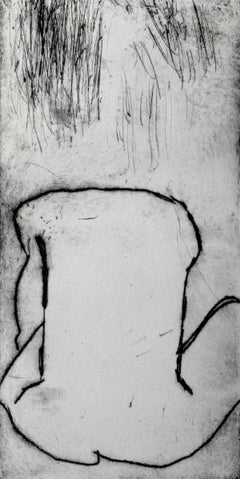People Nude Prints
to
215
820
384
496
141
92
Overall Width
to
Overall Height
to
564
503
167
133
71
49
31
18
13
10
8
4
3
1
69
54
53
49
28
19
42
1,465
429
19
74
103
117
39
86
165
369
174
89
14
1,283
602
42
1,955
1,204
895
758
497
445
419
405
279
96
86
70
68
52
50
46
45
43
40
39
731
560
334
134
134
204
608
917
893
Art Subject: People
Salvador Dali - Head of Veal - Original Etching
Located in Collonge Bellerive, Geneve, CH
Salvador Dali - Head of Veal - Original Etching
Embossed signature
From the edition of 731
Dimensions: 38,5 x 28,5 cm
1969
References : Field 69-1 / Michler & Lopsinger 305
Category
1960s Surrealist Nude Prints
Materials
Etching
Amber Garden
Located in New York, NY
Arthur B. Davies (1862-1928), Amber Garden (Hand Raised, Autumn Mist), soft ground etching and aquatint, 1919, signed in pencil lower right margin. Referen...
Category
1910s American Impressionist Nude Prints
Materials
Etching, Aquatint
Reflection:Contemporary Limited Edition Etching
By Ian Laurie
Located in Brecon, Powys
Signed Limited Edition , 6 /25 , etching by this collected Scottish artist. Very pretty, mounted unframed.
Ian Laurie was born in 1933 and is a self taught artist who made the transition from industry to artistry around 40 years ago when he & his wife opened a gallery specialising in original, hand made prints by artists working in that medium. His own hobby of sketching soon became etching and it wasn't long before he was producing his own limited edition etchings...
Category
21st Century and Contemporary Modern Nude Prints
Materials
Etching
$200 Sale Price
20% Off
Leonor Fini - Road to Death - Original Lithograph
By Leonor Fini
Located in Collonge Bellerive, Geneve, CH
Leonor Fini - Road to Death - Original Lithograph
The Flowers of Evil
1964
Conditions: excellent
Edition: 500
Dimensions: 46 x 34 cm
Editions: Le Cercle du Livre Précieux, Paris
Un...
Category
1960s Modern Nude Prints
Materials
Lithograph
"Rebirth"- Colorful Nude in Water Photo
By John Mazlish
Located in Brooklyn, NY
Underwater nude shot from above a small cenote in Tulum, Mexico. Other size prints, framing options and print methods (such as fine art paper or face mounted plexiglass) available up...
Category
2010s Contemporary Nude Photography
Materials
Metal
Nude - Contemporary Figurative Etching Print, Female artist, Polish art
Located in Warsaw, PL
MARTA WAKUŁA-MAC: Master of Arts in Fine Art Education- Diploma in Fine Art Printmaking at the Institute of Art, Pedagogical University, Krakow, 2003. Member of Graphic Studio Dubl...
Category
2010s Contemporary Nude Prints
Materials
Paper, Etching
Nude on Stairs
By John Sloan
Located in New York, NY
John Sloan (1871-1951), Nude on Stairs, etching, 1930, signed in pencil lower right margin, titled in pencil center, inscribed “100 proofs” lower left [also signed in the plate lower...
Category
1930s American Realist Nude Prints
Materials
Etching
Salvador Dali - Pierre Curie - Original Handsigned Engraving
Located in Collonge Bellerive, Geneve, CH
Salvador Dali - Pierre Curie - Original Handsigned Engraving
Dimensions: 17.5 x 12.5 cm
1970
Signed in pencil
EA
Jean Schneider, Basel
References : Field 70-5
Provenance : Schneider ...
Category
1960s Surrealist Nude Prints
Materials
Engraving
The Rounder Pop Art Mel Ramos Nude Boxing Print Lithograph blue
By Mel Ramos
Located in Zug, CH
MEL RAMOS (1935-2018)
The Rounder
1999
Lithograph
92.1 x 48.9 cm
36.26 x 19.25 inches
Edition of 199 with HC 20
Edition HC 12/20
Signed and numbered in pencil
Category
20th Century Figurative Prints
Materials
Lithograph
Doel Reed “Nude with Winter Bouquet” 1972 Aquatint Etching, Signed, Framed
By Doel Reed
Located in Denver, CO
Nude with Winter Bouquet is an exquisite 1972 aquatint etching by celebrated American printmaker Doel Reed (1894–1985), masterfully capturing a reclining female nude beside a winter ...
Category
1970s American Modern Portrait Prints
Materials
Aquatint, Etching
Leonor Fini - Nimphs - Original Handsigned Lithograph
By Leonor Fini
Located in Collonge Bellerive, Geneve, CH
Leonor Fini - Nimphs - Original Handsigned Lithograph
Circa 1982
On colored paper
Handsigned and Numbered
Edition: 275
Dimensions: 69 x 52.5 cm
Category
1980s Modern Nude Prints
Materials
Lithograph
Pablo Picasso (after) Helene Chez Archimede - Wood Engraving
Located in Collonge Bellerive, Geneve, CH
Pablo Picasso (after)
Helene Chez Archimede
Medium: engraved on wood by Georges Aubert
Dimensions: 44 x 33 cm
Portfolio: Helen Chez Archimede
Year: 1955
Edition: 240 (Here it is on...
Category
1950s Cubist Figurative Prints
Materials
Engraving, Woodcut
Torment
Located in New York, NY
Arthur B. Davies (1862-1928), Torment, soft ground etching with aquatint and roulette, 1919-20, signed with the estate stamp lower right, and signed by the printer Frank A. Nankivell...
Category
1910s American Impressionist Nude Prints
Materials
Etching, Aquatint
Against Green
Located in New York, NY
Arthur B. Davies (1862-1928), Against Green (also Three Figure Composition, Figures Against Green), soft ground etching and aquatint, 1918, signed in pencil lower right; also titled ...
Category
1910s American Impressionist Figurative Prints
Materials
Etching, Aquatint
By the Sea (aka Idyll)
Located in New York, NY
Arthur B. Davies (1862-1928), By the Sea (aka Idyll), soft ground etching and aquatint, 1919, signed in pencil lower right. Reference: Czestochowski 72, fourth state (of 5; see disc...
Category
1910s American Impressionist Nude Prints
Materials
Etching, Aquatint
Snow Crow
By John Denning
Located in Glen Ellen, CA
Denning is best known for his bronze figurative sculptures and his watercolors on paper. This work, Snow Crow, is a dye sublimation transfer on aluminum with a gloss finish. Denning ...
Category
21st Century and Contemporary Contemporary Nude Prints
Materials
Aluminum
On point - Contemporary Figurative Etching Print Nude Monochromatic
Located in Warsaw, PL
Polish painter and graphic designer, Czeslaw Tumielewicz was born in 1942.
In 1968, he studied at the Architecture faculty of Gdank, before continuing his course at the Technical Un...
Category
2010s Contemporary Figurative Prints
Materials
Paper, Etching
"Coda" archival print, oil paint and mixed media work encased in resin
Located in Boca Raton, FL
"Coda" by artist Raphael Mazzucco. Archival print of nude woman floating in water with oil paint and mixed media encased in beautifully aged resin in...
Category
2010s Contemporary Figurative Prints
Materials
Resin, Mixed Media, Oil, Color
Communion
By Eileen Cooper
Located in London, GB
Eileen Cooper is a distinguished British artist celebrated for her expressive and dynamic prints that often explore themes of femininity, relationships, and the natural world. Her wo...
Category
1990s Contemporary Figurative Prints
Materials
Etching
Domergue - Naked - Original Signed Lithograph
Located in Collonge Bellerive, Geneve, CH
Original Lithograph by Jean-Gabriel Domergue
Title: Naked
Signed
Dimensions: 40 x 31 cm
1956
Edition of 197
This artwork is part of the famous portfolio "La Parisienne"
Jean-Gabrie...
Category
1950s Impressionist Nude Prints
Materials
Lithograph
Kees Van Dongen - Les Lepreuses - Original Portfolio with 26 Lithographs
Located in Collonge Bellerive, Geneve, CH
TITLE : Les Lepreuses (text by Heny de Montherlant)
EDITOR : NRF, Paris 1946
PRESENTATION : in-4 in leaves under slipcase
ILLUSTRATION : 26 original lithographs by Kees VAN DONGEN (w...
Category
1940s Modern Nude Prints
Materials
Lithograph
Standing Male Nude - Lithograph - 2007
By Egon Schiele
Located in Roma, IT
Standing Male Nude is a beautiful colored lithograph from the portfolio " Erotica " after Egon Schiele.
It deals with a reproduction of the homonym artwork realized in pencil by Eg...
Category
Early 2000s Modern Figurative Prints
Materials
Lithograph
Crouching Male Nude (Self Portrait) - Lithograph - 2007
By Egon Schiele
Located in Roma, IT
Crouching Male Nude (Self-Portrait) is a lithograph from the portfolio " Erotica " after Egon Schiele.
It is a reproduction of the homonym black crayon drawing, a self-portrait real...
Category
Early 2000s Modern Figurative Prints
Materials
Lithograph
Jean Cocteau (after) - Carmen - Lithograph
By Jean Cocteau
Located in Collonge Bellerive, Geneve, CH
Lithograph after a drawing by Jean Cocteau
Title: Carmen
1971
Dimensions: 38 x 28 cm
Lithograph made for the portfolio "Gitans et Corridas" published by Société de Diffusion Artistique
Category
1960s Modern Nude Prints
Materials
Lithograph
Giclée Print: 'EMMA'
Located in New York, NY
GRAPHICTHERAPY is David Calderley:
an Englishman in New York, Creative/Art Director, Graphic Designer and Illustrator. After graduating from the esteemed St. Martin’s School of Art in Covent Garden, London and beginning a freelance career, he moved to New York City in 1990. Over the last 30+ years he has designed over 1200 albums and single covers, as well as promotional and full campaigns for a myriad of artists including, Interpol, Madonna, The White Stripes, RZA, Moby, The Black Crowes, Elvis Costello, to name a few.
After a 10 year spot as the Creative Director for Sir Richard Branson’s North American Record Label V2, he set up GRAPHICTHERAPY in 2007, a small boutique creative agency that offers a complete range of design services, both in print and media.
A unique mix of art direction, design and creative illustration can be seen across a wide variety of brands, products and publications in music, fashion, events and campaigns. His largest illustrated piece is a 90ftx50ft mural on 57th and Park Avenue for the British menswear company, Turnbull & Asser, as part of their rebrand. David’s work has been recognized by numerous global companies and publications, and has won several industry awards. He continues to work from his studio in Harlem.
This capsule of collage/mixed media prints:
‘Eating Vinegar with A Fork,’ reflecting a dry wit, as suggested in the title; juxtaposing formal Victorian etchings...
Category
2010s Contemporary Figurative Prints
Materials
Giclée
Nude with a glass - XXI Century, Figurative Monotype Print, Monochromatic
Located in Warsaw, PL
Siergiej Timochow, a Belorussian artist, born in 1960.
He studied at an art school in Minsk in 1979 before continuing to study at the Fine Arts Academy in Belarus.
His acrylic and ...
Category
Early 2000s Contemporary Figurative Prints
Materials
Cardboard, Monotype
Nude with raised legs - XXI Century, Contemporary Figurative Monotype Print
Located in Warsaw, PL
Siergiej Timochow, a Belorussian artist, born in 1960.
He studied at an art school in Minsk in 1979 before continuing to study at the Fine Arts Academy in Belarus.
His acrylic and ...
Category
Early 2000s Contemporary Figurative Prints
Materials
Cardboard, Monotype
Nude - XXI Century, Contemporary Figurative Monotype Print
Located in Warsaw, PL
Siergiej Timochow, a Belorussian artist, born in 1960.
He studied at an art school in Minsk in 1979 before continuing to study at the Fine Arts Academy in Belarus.
His acrylic and ...
Category
Early 2000s Contemporary Figurative Prints
Materials
Cardboard, Monotype
Salvador Dali - Cup of Chocolate
Located in Collonge Bellerive, Geneve, CH
Salvador Dali - Cup of Chocolate - Original Etching
Dimensions: 38 x 28 cm
Edition: 390
1967
On Rives Vellum
References : Field 67-4 (p. 32-33) / Michler & Lopsinger 174 to 187.
Category
1960s Surrealist Nude Prints
Materials
Etching
"Two Birds" Black & White Photography 42" x 30" in Edition 1/7 by Larsen Sotelo
Located in Culver City, CA
"Two Birds" Black & White Photography 42" x 30" in Edition 1/7 by Larsen Sotelo
Not framed. Ships in a tube
Giclee (Archival Ink) print on 310G Platine Fibre Cotton Rag w/satin fini...
Category
21st Century and Contemporary Modern Nude Prints
Materials
Archival Ink, Rag Paper, Giclée
Naked with Cactus and dog in the Mexican Living Room
By Jenny Toth
Located in Brooklyn, NY
This is an artist proof aquatint of a woman stepping forward in a tiled Mexican living room with her dog and a mysterious giant cactus coming out of the floor. Image is 9.75 x 9.75 ...
Category
2010s Feminist Nude Prints
Materials
Paper, Ink, Aquatint
Nude - Etching by Nazareno Gattamelata - 1970s
Located in Roma, IT
Nude is a black and white etching realized by Nazareno Gattamelata in the 1970s.
Hand signed by the artist on the lower right margin: Gattamelata.
Numbered on the lower left margin...
Category
1970s Contemporary Figurative Prints
Materials
Etching
Leonor Fini - Lovers - Original Lithograph
By Leonor Fini
Located in Collonge Bellerive, Geneve, CH
Leonor Fini - Lovers - Original Lithograph
The Flowers of Evil
1964
Conditions: excellent
Edition: 500
Dimensions: 46 x 34 cm
Editions: Le Cercle du Livre Précieux, Paris
Unsigned ...
Category
1960s Modern Nude Prints
Materials
Lithograph
Study From the Nude of a Girl Lying Down
Located in New York, NY
Theodore Roussel (1847-1926), Study From the Nude of a Girl Lying Down, 1890, drypoint with plate tone, signed with the tab and inscribed “imp” [also ...
Category
1890s Impressionist Nude Prints
Materials
Drypoint
"Twin Kate Moss on Pink" Photography 30 x 27.5 in Edition of 25 by Kate Garner
By Kate Garner
Located in Culver City, CA
"Twin Kate Moss on Pink" Photography 30 x 27.5 in Edition of 25 by Kate Garner
Hahnemuhle fine art archival paper
Kate Garner: Seeker, Sage, and Preservationist of Identity
A thou...
Category
20th Century Contemporary Nude Photography
Materials
Archival Ink, Archival Paper
"E-motion" Nude Photography 32 x 47 in Ed. of 15 by Yevgeniy Repiashenko
Located in Culver City, CA
"E-motion" Nude Photography 32 x 47 in Ed. of 15 by Yevgeniy Repiashenko
"E-motion" by Yevgeniy Repiashenko
Year photo was taken: 2013
Art Print
Limited Edition of 15
Picture size:
Height: 32" inch
Width: 47" inch
* * * NOT framed - ships in a tube * * *
This is an archival pigment print on photo paper with 1" float border (not included in listed image dimensions). Prints are signed and numbered by the artist on verso and come with a certificate of authenticity.
ABOUT THE ARTIST
Yevgeniy Repiashenko is a well-versed photographer working in such genres as dynamic dance and sculpture, portrait, and fashion...
Category
21st Century and Contemporary Contemporary Nude Photography
Materials
Pigment
"Dust" archival print, oil paint and mixed media encased in resin by Mazzucco
Located in Boca Raton, FL
"Dust" by artist Raphael Mazzucco. Archival print of a nude woman at White Sands, New Mexico, with oil paint and mixed media encased in resin.
Category
2010s Contemporary Figurative Prints
Materials
Resin, Mixed Media, Oil, Color
Pablo Picasso Femme couchée et homme au grand chapeau, 1962
Located in Torino, IT
PABLO PICASSO, Malaga 1881 - Mougins 1973
Femme couchée et homme au grand chapeau, 1962
Linoleoumography d'après in color. (mm270x325)
Perfect specimen published by the Cercle d'Art ...
Category
1960s Cubist Nude Prints
Materials
Linocut
Bathing Nude - Lithograph by Robert Fonténé - Mid 20th Century
Located in Roma, IT
Bathing Nude is a lithograph on paper realized by Robert Fontené in the mid-20th Century.
Hand-signed on the lower right.
Numbered on the lower left, ...
Category
Mid-20th Century Contemporary Figurative Prints
Materials
Lithograph
Nude - Monotype by Louis-Albert Demangeon - Mid 20th Century
Located in Roma, IT
Nude is a Monotype print realized by Louis-Albert Demangeon in the mid-20th century.
Hand-signed
In Good condition.
The artwork is depicted through soft strokes in a well-balanced...
Category
Mid-20th Century Modern Figurative Prints
Materials
Lithograph, Monotype
Salvador Dali - The Drawers
Located in Collonge Bellerive, Geneve, CH
Salvador Dali - The Drawers - Original Etching
Dimensions: 38 x 28 cm
Edition: 235
1967
Embossed signature
On Arches Vellum
References : Field 67-10 (p. 34-35)
Category
1960s Surrealist Nude Prints
Materials
Etching
Kahir
Located in New York, NY
Richard Meier
Kahir, 2011
Silkscreen Collage (mix media),
sheet size: 30" x 30"
signed numbered dated in pencil by the artist
edition of 50
Richard Meier, (b.1934) most know...
Category
2010s Contemporary Figurative Prints
Materials
Mixed Media, Screen
$2,400
Nude 8 - Lithograph by Carlo Marcantonio - 1970 ca.
Located in Roma, IT
Hand Signed. Edition of 50 prints plus some Artist's Proofs.
Very good condition.
Category
1970s Contemporary Figurative Prints
Materials
Lithograph
Seated Figure (framed hand signed etching)
By Henry Moore
Located in Aventura, FL
Etching on paper. Hand signed lower right by Henry Moore. Hand numbered 49/50 lower left. Sheet size 18.5 x 15 inches. Image size 8.625 x 6.5 inches. Frame size: approx. 24 x 2...
Category
1970s Modern Nude Prints
Materials
Paper, Etching
$1,837 Sale Price
25% Off
Nude in Woods - Etching by Ker Xavier Roussel - 1920s
Located in Roma, IT
Nude in Woods is an original etching print artwork on ivory-colored paper realized by Ker-Xavier Roussel in 1920 ca.
Hand-Signed on the lower right margin.
Very Good conditions.
Ker-Xavier Roussel (Lorry-les-Metz,1867 – L'Étang-La-Ville, 1944), the French artist, together with his friend Édouard Vuillard , studied at the artist studio of the painter Diogène Maillart. In 1888, he attended the École des Beaux-Arts, and then he studied at the Académie Julian where Maurice Denis and other artists formed the group Les Nabis , shifting towards mythological compositions with clear and luminous palettes of color. As a matter of fact, he is well-known for his paintings of French landscapes, usually depicting nymphs and fauns, women, and children in bucolic settings. In Gertrude Stein's Autobiography o f Alice B...
Category
1920s Modern Figurative Prints
Materials
Etching
Nude in Woods - Etching by Ker Xavier Roussel - 1920s
Located in Roma, IT
Nude in Woods is an original etching print artwork on ivory-colored paper realized by Ker-Xavier Roussel in 1920 ca.
Hand-Signed on the lower right margin.
Very Good conditions.
Ker-Xavier Roussel (Lorry-les-Metz,1867 – L'Étang-La-Ville, 1944), the French artist, together with his friend Édouard Vuillard , studied at the artist studio of the painter Diogène Maillart. In 1888, he attended the École des Beaux-Arts, and then he studied at the Académie Julian where Maurice Denis and other artists formed the group Les Nabis , shifting towards mythological compositions with clear and luminous palettes of color. As a matter of fact, he is well-known for his paintings of French landscapes, usually depicting nymphs and fauns, women, and children in bucolic settings. In Gertrude Stein's Autobiography o f Alice B...
Category
1920s Modern Figurative Prints
Materials
Etching
Nude from Back - Original Etching by Henri Farge - Early 20th Century
Located in Roma, IT
Nude from Back is an original modern artwork realized in the first decades of the 20th Century by the French artist Henri Farge (1884-1970).
Original et...
Category
Early 20th Century Modern Figurative Prints
Materials
Etching
NUDE WITH BOUQUET AND STOCKINGS
Located in Aventura, FL
Screenprint on museum board. Hand signed and numbered by the artist. HC edition. Sheet size 44 x 80 inches. Published by International Images, Putney, Vermont. Artwork is in exce...
Category
1990s Pop Art Nude Prints
Materials
Screen, Board
Irving Place Burlesque, lithograph, 1928
Located in New York, NY
Reginald Marsh (1898-1954), Irving Place Burlesque, lithograph, 1928, signed in pencil lower right and inscribed 25 proofs lower left margin [also signed and dated in the plate upper...
Category
1920s American Impressionist Nude Prints
Materials
Lithograph
Salvador Dali - Henry Wadsworth Longfellow - Original Handsigned Etching
Located in Collonge Bellerive, Geneve, CH
Salvador Dali - Henry Wadsworth Longfellow - Original Handsigned Etching
Dimensions: 38 x 28 cm
1967
Signed in pencil
EA in Sanguine
Jean Sc...
Category
1960s Surrealist Nude Prints
Materials
Etching
Nudes em 08
By Thomas Ruff
Located in New York, NY
A very good impression of this Iris print. Signed and numbered 23/50 on verso by Ruff.
Category
Early 2000s Contemporary Nude Prints
Materials
Color
Salvador Dali - Jonas Salk - Original Handsigned Engraving
Located in Collonge Bellerive, Geneve, CH
Salvador Dali - Jonas Salk - Original Handsigned Engraving
Dimensions: 17.5 x 12.5 cm
1970
Signed in pencil
EA
Jean Schneider, Basel
References : Field 70-5
Category
1960s Surrealist Nude Prints
Materials
Engraving
Rest - Original Etching by Leo Guida - 1989
By Leo Guida
Located in Roma, IT
With the Ghost is an original etching and aquatint realized by Leo Guida in 1985.
Good condition.
Mounted on a white cardboard passpartout (50x35).
Dated and signed by the author....
Category
1980s Contemporary Nude Prints
Materials
Etching
Woman with Signals - Original Etching by Leo Guida - 1989
By Leo Guida
Located in Roma, IT
Woman with Signals is an original etching and aquatint realized by Leo Guida in 1989.
Good condition.
Mounted on a white cardboard passpartout (50x35).
Dated and signed by the aut...
Category
1980s Contemporary Nude Prints
Materials
Etching
Il Crollo - Original Etching by Leo Guida - 1975
By Leo Guida
Located in Roma, IT
Il Crollo (The Collapse) is an original Contemporary artwork realized by the italian Contemporary artist Leo Guida (1992 - 2017), in 1975s.
Original black and white etching on pap...
Category
1970s Contemporary Figurative Prints
Materials
Etching
Fingono di Dormire - Original Etching by Leo Guida - 1975
By Leo Guida
Located in Roma, IT
Fingono di Dormire is an original Contemporary artwork realized by the italian Contemporary artist Leo Guida (1992 - 2017), in 1975.
Original black and white etching on paper.
Ver...
Category
1970s Contemporary Figurative Prints
Materials
Etching
Nude Woman - Vintage Offset by Franco Gentilini - 1970s
Located in Roma, IT
Nude Woman is an original vintage offset print on ivory-colored paper, realized by Franco Gentilini ( Italian Painter, 1909-1981), in 1970s.
The state of preservation of the artwor...
Category
1970s Modern Figurative Prints
Materials
Offset
Nude Woman - Vintage Offset by Franco Gentilini - 1970s
Located in Roma, IT
Nude Woman is an original vintage offset print on ivory-colored paper, realized by Franco Gentilini ( Italian Painter, 1909-1981), in 1970s.
The state of preservation of the artwor...
Category
1970s Modern Figurative Prints
Materials
Offset
No title (No 31) Art print 36 x 36 inch Edition of 28 by Yevgeniy Repiashenko
Located in Culver City, CA
No title (No 31) Art print 36 x 36 inch Edition of 28 by Yevgeniy Repiashenko
Year photo was taken: 2018
Art Print
Limited Edition of 28
Picture size:
Height: 36" inch
Width: 36" i...
Category
21st Century and Contemporary Contemporary Nude Photography
Materials
Archival Paper, Pigment
Lying Nude - Original Etching by N. Gattamelata - 1970s
Located in Roma, IT
Figure is a black and white etching realized by Nazareno Gattamelata in 1970s.
Hand signed by the artist on the lower right margin: Gattamelata.
Good conditions.
Category
1970s Contemporary Figurative Prints
Materials
Etching




